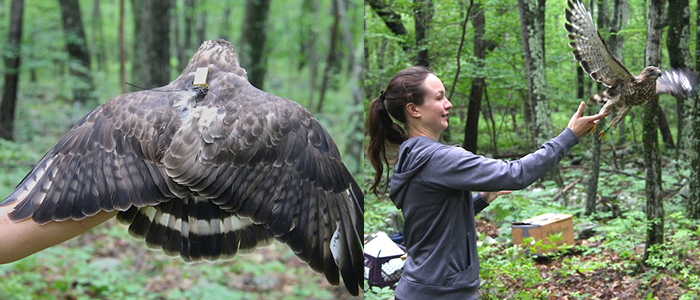ESU Graduate Student Conducts Breaking Research on Broad-winged Hawks

Posted by: admin on September 16, 2015, No Comments
 Using satellite transmitters to track the movements of Broad-winged Hawks is just one component of ESU graduate student Rebecca McCabe’s ground breaking research on this species over the last three years.
Using satellite transmitters to track the movements of Broad-winged Hawks is just one component of ESU graduate student Rebecca McCabe’s ground breaking research on this species over the last three years.
Beginning as an intern at Hawk Mountain Sanctuary, Rebecca started taking graduate biology classes with Terry Master, Ph.D., in 2014.
Rebecca’s thesis research expanded from Hawk Mountain and southeastern Pennsylvania to include the Pocono Plateau in an effort to compare nesting behavior between fragmented habitat in the south and larger, forested landscapes in the Poconos.
The project originated and is based at Hawk Mountain Sanctuary where it is under the overall supervision of Laurie Goodrich, Ph.D., senior monitoring biologist. It has attracted crowd funding, grants from The Pennsylvania Game Commission (State Wildlife Grant), Pennsylvania Audubon, private donors and a Faculty Development Research (FDR) sponsored major leveraging grant from ESU to fund the Pocono portion of the project.
She and student interns, including undergraduates Randy Farley, a junior majoring in Environmental Studies from Hardwick, NJ, and Cassie Baun, a senior majoring in biology from Nazareth, Pa., conducted observations both directly and through use of remote cameras, determined habitat use directly and by using GIS-based land cover photographs, and are using satellite transmitters to track migratory pathways and movements on their wintering grounds in the neotropics.
During 2014-2015, an adult named Abbo was tracked from her nesting site in southeastern Pennsylvania to wintering habitat in Peru and Brazil and back to a new nesting site in Berks County this spring — traveling a total distance of 11,000 miles! This year, the solar-powered transmitters, each costing thousands of dollars, have been attached to four adults, three of which are from the Poconos. Locations are determined on alternate days resulting in a map showing the birds’ movements that can be accessed at www.hawkmountain.org/birdtracker/.
One of the three Pocono birds, Pocono Penny, chose the ropes course at Stony Acres as her nesting site. Thanks to the stewardship efforts of Program Coordinator Madeline Constantine and the Stony Acres staff, disturbance from visiting groups was limited resulting in a successful nesting season for Penny. This is only the second study using satellite transmitters on individuals of this species, but this effort is much more extensive and provides more frequent location data on more birds as they travel to and from the neotropics.
Broad-winged Hawks are common breeders in Pennsylvania and among the most common passage migrants during the fall at eastern hawk-watch sites like Hawk Mountain. However, their nesting population has declined by 16% in the last 20 years according to intensive statewide surveys. Observation and tracking data will provide new insights into the natural history of this hawk, highlight the conservation needs of the species throughout its annual cycle, and be incorporated into a management plan to halt the ongoing population decline. The project also serves as an example of the value of collaboration among funding agencies, a private conservation organization and an academic institution.
For more information contact Dr. Master at 570-422-3709 or tmaster@esu.edu.




